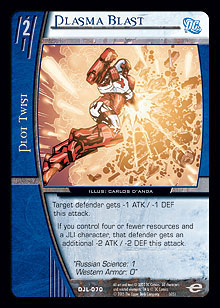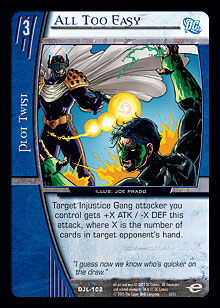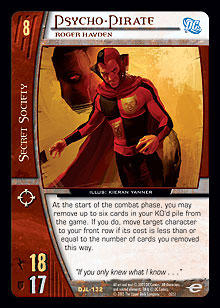Sneak Preview tournaments are always enormously fun. You get to play with cards you’ve never seen before and test your skills against other players on a level playing field. Last week, I gave you guys the list of what I opened and asked you to build it for yourselves and send me what you came up with. Before I get to your results, I’ll go over the process I went through and the deck I ended up building. Please note that this process isn’t the only way to go about building a Sealed Pack deck, but it’s the one that I use and it has served me well.
The first thing I do when opening a sealed pack is separate everything out. Plot twists go in one pile, locations in another, and equipment in another. I then break up the characters into their various affiliations. For this set, I broke them down by the major affiliations only. It would be overkill to separate all of them by both of their affiliations.
After separating the cards into their respective piles, I then go through the process of weeding out the unplayable cards. This mostly applies to the non-character cards. Until I figure out how good or bad the curve is for my deck, I really can’t discount any characters. As for the other cards, I’ll let you know what I look for.
 Plot twists need to serve a purpose that I need filled in order to stay on the squad. The first cards I look to keep are those that affect combat somehow. Cards like Plasma Blast and All Too Easy are examples of cards that I won’t hesitate to keep in my maybe pile. The next cards I look for are good Team-Ups. I got lucky and opened three of them—Justice League of Arkham, Funky’s Big Rat Code, and Justice League Task Force. The final category of cards I look for is a little vaguer. If you check back to my “Manual” article series, I have a big section on plot twists. Generally, any plot twists that are good in Draft are also good in Sealed Pack. This includes KO effects, cards that increase consistency, and cards that enhance major themes for teams you might play.
Plot twists need to serve a purpose that I need filled in order to stay on the squad. The first cards I look to keep are those that affect combat somehow. Cards like Plasma Blast and All Too Easy are examples of cards that I won’t hesitate to keep in my maybe pile. The next cards I look for are good Team-Ups. I got lucky and opened three of them—Justice League of Arkham, Funky’s Big Rat Code, and Justice League Task Force. The final category of cards I look for is a little vaguer. If you check back to my “Manual” article series, I have a big section on plot twists. Generally, any plot twists that are good in Draft are also good in Sealed Pack. This includes KO effects, cards that increase consistency, and cards that enhance major themes for teams you might play.
Death Times Five was my first cut. I’ve never been a really big fan of cards that have this effect. Unless it actually allows your deck to win a turn faster than it normally would, the effect just isn’t that great. Ultimately, regardless of any extra breakthrough you do, your opponent will most likely be able to do enough endurance loss to you to more than make up for it if he or she has the initiative on the final turn of the game.
World War III has far too great a cost for its effect. The only time it would be really effective is on a late turn when you’ve caused enough endurance loss to your opponent to defeat him or her and you want to make sure that you don’t get killed back. However, it would need to be your initiative, you would have to have most (if not all) of your guys survive, and you would have to have stunned your opponent’s largest characters. This card KO’s your opponent’s guys based on the number of characters you KO, not the cost of those characters. This means that it would probably be quite difficult for you to KO your opponent’s larger characters unless you had a massive army to spare, and if you did, you’d be winning anyway.
Those were all of the cuts I made. I opened a fair number of decent plot twists, and even the ones that looked weaker really had potential within their respective teams. In order to determine the next round of cuts, I had to decide what teams I would be playing.
The first step in determining teams is to lay out all of your characters by cost. This will give you a good idea about which parts of the curve in your sealed pack are strong and which are weak. Upon laying out my characters, I noticed that I had a pretty decent curve. This meant that I could be a little more concerned with making sure my deck was limited in teams. I began by cutting the unaffiliated characters. Rama Khan, Professor Ivo, and Queen of Fables didn’t intrigue me much, so they went to the cut pile. Next, I cut any legacy cards that weren’t good enough to make the deck. This meant Maxima and Valkyra wouldn’t be seeing the light of play. Both could be alright if you had enough of the other cards that made them good, but my deck sadly couldn’t support them, so I cut them for consistency’s sake.
This left me with the arduous task of cutting main teams. I started by checking out my 7-drops. Usually, it’s not terribly necessary for your 7-drops to be on the same teams as the rest of your deck, but I’d opened a couple of exceptions. Guy Gardner, Egomaniac only gives his bonus to JLI and GL characters you control. Mark Desmond ◊ Blockbuster only gets his enormously powerful benefit if you have ten cards in your KO’d pile. That isn’t easily accomplished unless you are playing Secret Society and abusing their theme. I decided that I really wanted to take advantage of both of these characters, and the fact that I had both JLI and Secret Society team-stamped Team-Ups encouraged me to make them my two teams.
 My next step was to cut all of the characters I had that weren’t Secret Society or JLI. This would give me a rough skeleton and allow me to see where I needed more drops. Cutting down to just those two teams left me with only two 3-drops and three 4-drops. I ideally wanted to have around four 3- and 4-drops each. Neither the JLA nor the Injustice Gang cards really stood out in terms of power level, so I checked my locations and plot twists to determine which team brought more to the table. Ultimately, I decided that All Too Easy was close enough to Savage Beatdown that it warranted an appearance.
My next step was to cut all of the characters I had that weren’t Secret Society or JLI. This would give me a rough skeleton and allow me to see where I needed more drops. Cutting down to just those two teams left me with only two 3-drops and three 4-drops. I ideally wanted to have around four 3- and 4-drops each. Neither the JLA nor the Injustice Gang cards really stood out in terms of power level, so I checked my locations and plot twists to determine which team brought more to the table. Ultimately, I decided that All Too Easy was close enough to Savage Beatdown that it warranted an appearance.
This left me with a nearly perfect character base, so I moved on to the support cards. In any given sealed pack, I try to shoot for around ten or so support cards. This includes plot twists, equipment, and locations. Unfortunately, I still had about twenty-five in my maybe pile. I started by taking the extremely powerful combat plot twists, such as All Too Easy, Plasma Blast, and UN Recognition, and putting them into the deck. I then decided that the effects that The Plunder Plan and Lead by Example generated were strong enough to warrant inclusion. Next, I added the two team-stamped Team-Ups I had—Funky’s Big Rat Code and Justice League Task Force. For the last two cards in the deck, I decided that I would add Nth Metal and Mysterious Benefactor. Nth Metal just seemed like a really powerful card; it gives +1 ATK / +1 DEF on attack and defense and triggers ally. As for Mysterious Benefactor, I had good leaders at almost every drop, including the incredibly powerful Martian Manhunter, J’onn J’onnz and Gorilla Grodd. It allowed me to make my draws a little more consistent and to get some incredibly powerful drops in the late game.
My final deck was as follows:
Characters
Manhunter Clone
James Jesse ◊ Trickster
Maxwell Lord
Booster Gold
IQ
Dr. Sivana
Rocket Red #4
The Shark, Karshon
Henry King ◊ Brainwave
Hector Hammond, Mind Over Matter
Kimiyo Hoshi ◊ Dr. Light, Starlight Sentinel
The Joker, Headline Stealer
Crystal Frost ◊ Killer Frost
Darkseid, Heart of Darkness
Martian Manhunter, J’onn J’onnz
Fire
Gorilla Grodd
Remoni-Notra ◊ Star Sapphire, Zamoran Champion
Captain Atom
Mark Desmond ◊ Blockbuster
Guy Gardner, Egomaniac
Plot Twists
Mysterious Benefactor
Funky’s Big Rat Code
Justice League Task Force
Lead by Example
The Plunder Plan
Plasma Blast
UN Recognition
All Too Easy
Equipment
Nth Metal
 I went 3-2 with the deck at the Sneak Preview tournament. I wasn’t incredibly displeased with the deck, mostly because my losses were a little out of my control. In round 4, I was forced to mulligan and then whiffed on turns 1 through 3 while my opponent played characters on turns 2 through 7, never under-dropping once. That is a sure-fire recipe for a loss. In the final round, I was on the receiving end of a rather sound beating. I had the game under control the entire time and was set to kill my opponent on turn 8, but then he played Psycho-Pirate. He removed his KO’d pile and stole my 6-drop. He then KO’d his Psycho-Pirate using his Gorilla Grodd and stole one of my 7-drops. With most of my team now working for him, he made short work of me. Pretty sick stuff.
I went 3-2 with the deck at the Sneak Preview tournament. I wasn’t incredibly displeased with the deck, mostly because my losses were a little out of my control. In round 4, I was forced to mulligan and then whiffed on turns 1 through 3 while my opponent played characters on turns 2 through 7, never under-dropping once. That is a sure-fire recipe for a loss. In the final round, I was on the receiving end of a rather sound beating. I had the game under control the entire time and was set to kill my opponent on turn 8, but then he played Psycho-Pirate. He removed his KO’d pile and stole my 6-drop. He then KO’d his Psycho-Pirate using his Gorilla Grodd and stole one of my 7-drops. With most of my team now working for him, he made short work of me. Pretty sick stuff.
In hindsight, I would have made a couple of substitutions. I didn’t fully realize how good Slaughter Swamp was in the Secret Society deck until about the middle of the second round. You target yourself with all of the effects that put cards from your deck into your KO’d pile, and then Slaughter Swamp allows you to get any of the characters back. This effectively doubles your hand size and always allows you to have a character on curve. Not On My Watch is another card that I didn’t think would be great but that ended up being pretty good. With my card pool, I didn’t really see a whole lot of cards that it could stop. However, if you hold it until the last turns of the game, it becomes really powerful. First off, players usually wait until the last few turns of the game to blow their plot twists. This means that it is much more effective at stopping your opponent’s plot twists at the late stages of the game. Also, if your opponent doesn’t play any plot twists that you can stop, you can save yourself a boatload of damage by giving your more expensive characters invulnerability. It may even be enough to extend the game another turn and allow you to have the final initiative.
Next week, I’ll go over the builds that you guys sent me and tell you what I think of them. Also, now that I’ve had some more experience, stay tuned for a full breakdown of the set in the weeks to come.
Questions and comments can be sent to the_priceis_right@yahoo.com.